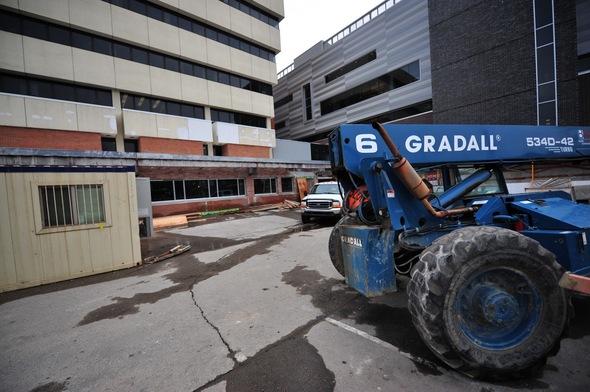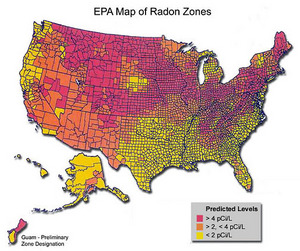Washtenaw County is a natural radon hotspot, and local experts suggest testing your home to be safe

Renovations are ongoing inside Ann Arbor's city hall, where high radon levels were recorded in the basement where police officers worked for many years until recently. The new police-courts building, at right, now houses the department's 124 sworn officers.
Ryan J. Stanton | AnnArbor.com
"The most important message that we have is for everyone to test their home for radon," said Angela Parsons, an environmental educator and radon expert with Washtenaw County Public Health. "Especially in this area, we have a rather high concentration of radon. Any home could have it — if it's new, old, big, small, has a basement, doesn't have a basement."
Parsons estimates about 40 percent of homes in the county have radon levels above 4 picocuries per liter of air, the level at which the U.S. Environmental Protection Agency recommends taking remedial action to avoid the risk of lung cancer.

This map shows Washtenaw County is a Zone 1 (red) area, meaning it has the highest potential for radon above the EPA action level of 4 pCi/L. Zone 2 (orange) means moderate potential and Zone 3 (yellow) means low potential.
It can enter homes through cracks in foundations, sump pump crocks, crawl spaces and other openings. It's the second leading cause of lung cancer in the United States, responsible for an estimated 21,000 deaths per year, according to the EPA.
Kurt Hudgins, president of Ann Arbor-based Protech Environmental Services, does radon testing and mitigation work all over Washtenaw County and Southeast Michigan.
"It's a pretty prevalent problem in the area that we're in," he agreed. "Radon comes from uranium decay in the soil and radon is actually one of the byproducts, so in the southern counties — Washtenaw, Lenawee, Hillsdale — all these counties definitely have higher issues with occurrence than when you get farther east and farther north."
Parsons said the county has home test kits available for $10, and the county keeps a database of results. In Ann Arbor's 48104 zip code, 533 tests conducted since the 1990s came back with an average reading of 5 pCi/L, while the highest was 44.9 pCi/L. Countywide, the highest reading recorded was 177.2 pCi/L, which Parsons called "pretty significant."
"And there's also been one that's 176 and 134," she said. "It's rare to get one over 100, but it wouldn't shock me to get one that high."
Tests conducted in the basement of Ann Arbor's city hall in recent years showed radon levels seven times the EPA action level, according to records obtained by AnnArbor.com.
Parsons was brought in by the city to educate employees about radon in May 2009, along with Kim Kearfott, a professor of nuclear engineering and radiology at the University of Michigan. They conducted two training sessions for a total of 125 city employees.
Parsons declined to comment on whether the levels inside city hall were safe, saying only, "There is no safe level of exposure to radon, according to the EPA."
Radon Special Report
Related coverage
- Ann Arbor Police chief says he was 'ashamed' of conditions police officers endured inside city hall
- Video testimony: Vada Murray believed radon, asbestos at Ann Arbor city hall caused his fatal lung cancer
- Radon and asbestos concerns in Ann Arbor city hall left police employees 'petrified about their health'
- High radon levels persisted in basement where Ann Arbor police officers worked, records show
Tests conducted by the Michigan Occupational Safety and Health Administration from March 11-16, 2009, showed radon levels ranging from 21.9 to 28.8 pCi/L in the city hall basement.
According to the EPA, if 1,000 people who never smoked were exposed to 20 pCi/L over a lifetime, about 36 could get lung cancer. The number goes up to 260 for smokers. Under the naturally occurring outdoor radon rate of 0.4 pCi/L, about 3 people could get lung cancer, the EPA estimates.
Despite the high readings, MIOSHA's inspection — which came in response to a complaint from the police officers union — never resulted in a citation.
Elaine Clapp, safety and health manager with MIOSHA, said the state agency follows U.S. Occupational Safety and Health Administration regulations, which set the maximum permissible workplace exposure limit at 100 pCi/L for 40 hours over seven consecutive work days. Unless a test done by MIOSHA showed levels above that, no citation can be issued.
"We can't enforce EPA levels," Clapp said, acknowledging OSHA has different standards. "I don't set those standards and I didn't create the science behind it. All we do is enforce the regulations. Whatever their rationale for doing it, we have to enforce their rationale."
Clapp said the thinking is that employees aren't exposed to the radon levels during their work shift in as long a duration as they would be if the same levels were in their home, so higher levels are tolerated by OSHA in the workplace.
Hudgins said most commercial buildings with modern-day heating and cooling systems have enough airflow to pressurize the building enough so that radon infiltration is not an issue.
"Or if there is a radon issue, many times balancing those systems can correct the issue," he said. "If it's not an adequate enough system, then sometimes you have to go with an active mitigation system like soil depressurization to reduce the levels."

A look at radon levels throughout the United States.
"They can get test kits through us, or they can get them through the county health department," he said. "They're typically around $10 to test their house and find out if they have an issue. That's the first and foremost step to take. It's a very easy test to do and very inexpensive."
Hudgins agreed it doesn't matter if the home has a basement or not. The concern, he said, is the level of the home that's in contact with the soil.
Parsons said tests are available from the county at its offices at 705 N. Zeeb Road or by calling 734-222-3869.
"That short-term test is a good screening device to see kind of where you are in the grand scheme of radon," Parsons said. "Because the levels do fluctuate due to a variety of reasons: weather patterns, different times of year, the operation of the heating and cooling system."
Because radon levels can fluctuate, Kearfott said, people shouldn't get too alarmed if a short-term test done over only a handful of days shows readings above the EPA action level. That just means more testing needs to be done, Kearfott said, but she still recommends following EPA guidelines. And if high levels persist, then there's a real concern.
Kearfott said the only known risk of radon exposure is lung cancer.
"And there's a latency period for it showing up," she said. "So you wouldn't see it really manifest for a while and you would have to be exposed to it for some time even at the higher levels. So for short time periods, you could be exposed to 100 and it's not an issue."
So what are some of the rules regarding radon?
"There are very limited regulations," Parsons said. "For the state of Michigan, if you know that you have radon or if you've done a radon test and you're selling your home, you need to list it on the seller's disclosure statement. And also homes that are used for child care need to be tested and have acceptable levels of radon, less than 4 pCi/L."
Because Washtenaw County is considered a "Zone 1" county, which means it has a higher likelihood of radon, new construction here must be done using radon-resistant techniques.
"And essentially what that means is when a new home is being built or an addition is being placed onto a home, they incorporate a radon mitigation system into that construction," Parsons said. "And it's a really good idea and it's really smart to do because it's much less expensive."
Parsons said the only other regulation she's aware of is Ann Arbor's housing code, which states that a basement can't be used as habitable space unless testing done by an independent third party shows acceptable levels of radon.
Mayor John Hieftje, who used to work in residential real estate, said he's very familiar with the issue because homes are often tested for radon when they're bought and sold.
"There's radon everywhere. Most people have it in their homes to some degree," he said. "A lot of places in Washtenaw County are way over — like 30 is probably not an unusual reading. In a lot of reports I've seen in my previous business, there would be spikes that would jump up pretty high. But it was the average over time you want to be below the action level of 4."
Ryan J. Stanton covers government and politics for AnnArbor.com. Reach him at ryanstanton@annarbor.com or 734-623-2529. You also can follow him on Twitter or subscribe to AnnArbor.com's e-mail newsletters.


Comments
Carole
Thu, Apr 21, 2011 : 12:36 p.m.
If it can be fixed, why wasn't city hall fixed after they found the levels to be extremely high?
paul wiener
Thu, Apr 21, 2011 : 3:03 a.m.
I thought it was odd that the article never mentions what to do if you find unacceptable levels of radon in your home. If there's nothing you can do except avoid a large part of your house, what's the point in knowing? I strongly don't agree that private tests should be a part of a public database: that'd be an absurd invasion of privacy, as well as opening one up to all kinds of misinterpretation, legal challenges and harrassment.
Awakened
Thu, Apr 21, 2011 : 11:01 a.m.
All new homes in the area are required to be built with a mitigation system. Essentially it is just a system that vents air from under the house so radon does not build up. Home systems are relatively inexpensive. Like a sump pump.
Kai Petainen
Wed, Apr 20, 2011 : 10:55 p.m.
How does the University of Michigan handle high radon levels? Perhaps you can compare/contrast?
say it plain
Wed, Apr 20, 2011 : 10:27 p.m.
@Craig brings up a point that seemed to be left undiscussed in the reports about testing at city hall--these continuously operating monitors! I thought I'd recalled that when I've gone looking at possible houses to buy around here, when there was a mitigation system installed, there would often also be a monitor like he describes, with an alarm that would indicate if the system were not working. I didn't recall how those alarms worked, whether they somehow were continually actually assessing levels of radon somehow or if they were assessing ventilation working properly or what. If these things exist, why wouldn't the city install them in their spaces?
Awakened
Thu, Apr 21, 2011 : 10:59 a.m.
If they acknowledged a problem they would have to fix it. They might also be responsible for Workers Compensation Claims. Apparently the problem was caught in the 1990s. A proper mitigation system would require extensive modifications including cutting open the basement of City Hall. So if they installed an inadequate mitigation system and built a new building the connection to cancer would not be provable. The new building, however, was delayed several years. They took the cheaper option, like Ford with the Pinto. A few deaths is cheaper than moving the PD until the new building was built. After all. They have insurance to pay for much of the health care cost.
Craig Lounsbury
Thu, Apr 21, 2011 : 1:24 a.m.
"If these things exist, why wouldn't the city install them in their spaces?" Good question. I can't speak to how these things work yet. I literally just ordered it on Amazon this afternoon.
Craig Lounsbury
Wed, Apr 20, 2011 : 10:08 p.m.
I just bought a digital tester for $129 that plugs in to the wall. It was recommended as one option from Consumer reports. It will test continually with an alarm similar to a smoke detector if readings exceed safe standards.
Craig Lounsbury
Thu, Apr 21, 2011 : 1:01 p.m.
I will add that the CR testing was done in 2008. The digital item rated a "good" in accuracy which is the equivalent to a 3 in a (poor)1-5(excellent) system. It rated a 4 in reliability
Craig Lounsbury
Thu, Apr 21, 2011 : 11:53 a.m.
A2, I bought this one...as I said I got the idea from Consumer Reports. <a href="http://www.amazon.com/Safety-Siren-Pro-HS71512-Detector/dp/B000CEAY64" rel='nofollow'>http://www.amazon.com/Safety-Siren-Pro-HS71512-Detector/dp/B000CEAY64</a>
A2anon
Thu, Apr 21, 2011 : 12:32 a.m.
Craig, which tester did you purchase?
Ann English
Wed, Apr 20, 2011 : 11:27 p.m.
Feminds me of what carbon monoxide detectors do. Carbon monoxide has a more subtle effect than smoke, but radon' s effects are the most subtle.
applehazar
Wed, Apr 20, 2011 : 9:38 p.m.
This is not an unusual event. Ann Arbor residents are over reacting. Yes Radon is harmful. But this is not new at all. I have owned 11 houses in 9 different states - NY, MA, ME, GA, TN, CA, MI. All but CA had radon over acceptable levels and all had mitigation units installed. They are guaranteed lifetime. People need to understand the easy mitigation process and every home should be tested and it is perfectly fine to have the testor install the unit - as again it is lifetime guaranteed. $600 - $800 is a small price to pay to eliminate this cancer causing issue - and no one should wait to sell their house to test. But alass most do. Like my seller here in MI.
a2grateful
Wed, Apr 20, 2011 : 9:03 p.m.
As usual, more questions than answers: 1) Has the dangerous radon level in the basement been mitigated? If so, when? 2) What are the levels now? 3) Has anyone considered that radon levels could have been high in city hall areas other than the basement? 4) Or, that maybe they still are? 5) What is the cost of mitigation compared to the cost of a folly fountain? 6) Radon mitigation supporting employee health, or folly fountain? If you governed in Ann Arbor, which would you choose?
Ryan J. Stanton
Wed, Apr 20, 2011 : 9:18 p.m.
I've got another story coming tomorrow that answers some of these questions. They are still working on the issue in the basement as they prepare it to be used as police locker facilities and meeting space. Final testing hasn't been done yet, but the goal is to end up with levels below 4 pCi/L, of course. To my knowledge, it's the basement that was the problem. Haven't been able to pin down a cost on the mitigation system but I've asked. There are many more questions, and they won't all be answered in a single story. Keep reading.
say it plain
Wed, Apr 20, 2011 : 8:36 p.m.
OOf, I would think twice about house-hunting with Mayor Hieftje at your side! It could be that his experience as a Realtor made him even more cavalier about this as a health issue, sick of those pesky house-buyers who care about such silly things and block his access to his fees for a sale over some mere gases lol! I don't know much about the details of radon testing, but presumably when an inspector trained to do these readings offer reports, they are not merely giving 'spike' data, but also the kinds of averages that would mean something vis a vis the kinds of considerations relevant to "habitable space". Now, hmm, why would a government standard for workplace use a higher action-level than residences would?! I can think of a few lobbying firms that might shed light lol, and I can imagine that it would be harder to justify voting against legislation that requires the EPA residence action-level guideline be enforced for childcare settings...just sayin'.
zeeba
Wed, Apr 20, 2011 : 8:12 p.m.
So where can you access the database of results? Seems it should be public information since the county is tracking it.
jcj
Wed, Apr 20, 2011 : 7:26 p.m.
I would never have radon levels tested by the person that would be doing the mitigation work!
leaguebus
Wed, Apr 20, 2011 : 8:38 p.m.
jcj is correct, I had to have the levels tested on a house that I have since sold, the company said there were high levels of Radon. I then got 3 kits from the county, did my own tests and they were all within acceptable levels. Of course, I was forced to spend $1000 to have a mitigation system installed.
Top Cat
Wed, Apr 20, 2011 : 6:57 p.m.
When I moved into my home in Dexter in 1988 the level of radon was over 50 pCi/L. I tested before I purchased the home as this was a known issue in New Jersey. The owners had no clue. It was not hard or expensive to fix it. There is no way to know it is there unless you test for it.